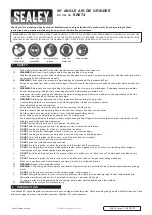
9
USAGE
Grinding
Turn on the machine and start grinding
a piece of scrap glass to get a ‘feel’ for
the grinding action. Begin by pushing
the glass into the grinding bit using light
pressure and moving the glass back and
forth across the bit. Slowly increase the
pressure until you feel comfortable with
the grinding speed and your control.
You’ll quickly learn the optimum grinding
pressure for the types of glass you
use. When grinding out deep cuts, use
intermittent pressure to allow coolant
to rinse ground glass from the head. If
you ever have a white paste form on
the bit, it is not getting enough coolant.
Stop, turn off the machine, and check
the sponge placement and coolant level.
Grinding without coolant greatly reduces
the life of your grinding heads.
As the diamond surface wears, you will
feel it grind less effectively. When this
happens, it is time to expose a new
portion of the diamond surface. Loosen
the set screw using the included Allen
wrench and move the grinding head up
on the shaft to expose a new 1/8" section
of diamond. Secure the bit back in place
making sure to tighten the set screw
against the flat side of the motor shaft.
Reposition the sponge if needed. You
have up to 5, 1/8" sections of exposed
diamond on a standard grinding bit
to use before you need to consider
replacing the entire head.
How to drill a hole in glass
The WizCG comes with a 1/4" grinding/
drilling bit. It is not included with the
WizlingCG. This 1/4" grinder bit is useful
for drilling holes and intricate grinding.
The 1/4" bit is placed onto the motor shaft
and sits on top of the 3/4" grinder bit.
Loosen the set screw with the included
Allen wrench, then slide the bit onto the
shaft, securing the set screw to the flat
side of the motor shaft. You need to supply
the coolant to the 1/4" bit while drilling by
using the other included sponge soaked in
coolant. Begin drilling the hole by holding
the front surface of the glass against the
upper edge of the bit at about a 45° angle,
while holding the coolant soaked sponge
against the bit and glass (Fig. D). You will
want to use two hands. Slowly move the
glass down onto the bit in a horizontal
position. Continue to work the glass down
and around the top of the bit in a circular
motion, making sure to keep the glass and
diamond wet at all times. You may need
to stop and soak the sponge with coolant
several times. Reduce pressure as you
Fig. D
begin to see the bit
come through the
back of the glass
to avoid chipping.
Practice before
you drill your final
project.






























